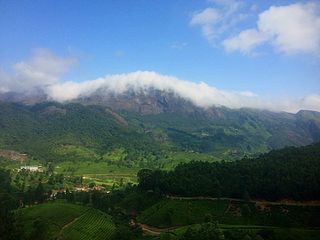
The Western Ghats, is a mountain range that covers an area of 160,000 km2 (62,000 sq mi) in a stretch of 1,600 km (990 mi) parallel to the western coast of the Indian peninsula, traversing the states of Karnataka, Goa, Maharashtra, Gujarat, Kerala, and Tamil Nadu. It is a UNESCO World Heritage Site and is one of the eight hotspots of biological diversity in the world. It is sometimes called the Great Escarpment of India. It contains a very large proportion of the country's flora and fauna, many of which are only found in India and nowhere else in the world. According to UNESCO, the Western Ghats are older than the Himalayas. They influence Indian monsoon weather patterns by intercepting the rain-laden monsoon winds that sweep in from the south-west during late summer. The range runs north to south along the western edge of the Deccan Plateau, and separates the plateau from a narrow coastal plain, called Konkan, along the Arabian Sea. A total of thirty-nine areas in the Western Ghats, including national parks, wildlife sanctuaries and reserve forests, were designated as world heritage sites in 2012 – twenty in Kerala, ten in Karnataka, six in Tamil Nadu and four in Maharashtra.

Konkan is the rugged section of the mid-western coast of the Indian Subcontinent, the coastal hinterland of Konkan consists of numerous riverine islands, river valleys, and the hilly slopes of the Western Ghats, that lead up into the tablelands of the Deccan region. Geographically, Konkan is bound by the Arabian Sea to the west, the Deccan plateau to the east. The Konkan coast proceeds from the north at Damaon in the Gulf of Cambay, extends southwards all along the western seaside areas of Maharashtra and Goa, and meets the Canara coast at the northern edge of Karwar District in Karnataka. The best-known islands of Konkan, are Ilhas de Goa, the site of the capital city of Panjim and Salsette Island on which Bombay (Mumbai), the capital of Maharashtra is situated.

Kàrāvàlī, also known as Kanara or Canara in Indo-British English, is the a historically significant stretch of land situated by the southwestern coast of India, alongside the Arabian Sea in the present-day Indian state of Karnataka. The region comprises of three civil districts, namely: Uttara Kannada, Udupi, and Dakshina Kannada.

The Koyna River is a tributary of the Krishna River which originates in Mahableshwar, Satara district, western Maharashtra, India. It rises near Mahabaleshwar, a famous hill station in the Western Ghats. Unlike most of the other rivers in Maharashtra which flow East-West direction, the Koyna river flows in North-South direction. The Koyna River is famous for the Koyna Dam and the Koyna Hydroelectric Project. Koyna Hydroelectric Project is the 2nd largest completed hydroelectric project in India. The reservoir – Shivasagar Lake, is a huge lake of 50 km in length.

The Madras Crocodile Bank Trust and Centre for Herpetology (MCBT) is a reptile zoo and herpetology research station, located 40 kilometres (25 mi) south of the city of Chennai, in state of Tamil Nadu, India. The centre is both a registered trust and a recognized zoo under the Wildlife (Protection) Act, 1972 and comes under the purview of the Central Zoo Authority, Ministry of Environment and Forests, Government of India. It was established with the aim of saving three Indian endangered species of crocodile—the marsh or mugger crocodile, the saltwater crocodile, and the gharial, which at the time of founding of the trust were all nearing extinction.
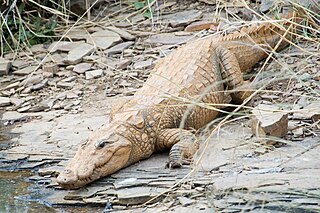
The mugger crocodile is a medium-sized broad-snouted crocodile, also known as mugger and marsh crocodile. It is native to freshwater habitats from southern Iran to the Indian subcontinent, where it inhabits marshes, lakes, rivers and artificial ponds. It rarely reaches a body length of 5 m and is a powerful swimmer, but also walks on land in search of suitable waterbodies during the hot season. Both young and adult mugger crocodiles dig burrows to which they retreat when the ambient temperature drops below 5 °C (41 °F) or exceeds 38 °C (100 °F). Females dig holes in the sand as nesting sites and lay up to 46 eggs during the dry season. The sex of hatchlings depends on temperature during incubation. Both parents protect the young for up to one year. They feed on insects, and adults prey on fish, reptiles, birds and mammals.
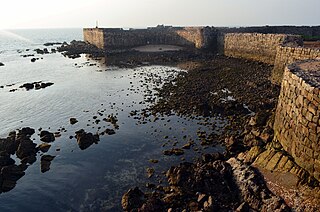
Sindhudurg is an administrative district in the state of Maharashtra in India, which was carved out of the erstwhile Ratnagiri district. The district headquarters are located at Oros. The district occupies an area of 5,207 km2 and has a population of 849,651 of which 12.59% were urban. As of 2011 it is the least populous district of Maharashtra.

Khed is a town with a municipal council in the Ratnagiri district of the state of Maharashtra, India. Situated on the Mumbai - Goa Highway, NH 66, it is surrounded by a number of villages.
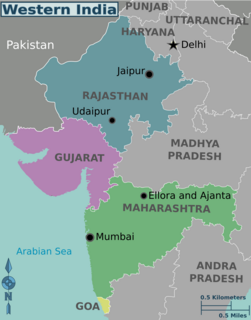
Western India is a loosely defined region of India consisting of its western part. The Ministry of Home Affairs in its Western Zonal Council Administrative division includes the states of Goa, Gujarat, and Maharashtra along with the Union territory of Dadra and Nagar Haveli and Daman and Diu, while the Ministry of Culture and some historians also include the state of Rajasthan. The Geological Survey of India includes Maharashtra but excludes Rajasthan whereas Ministry of Minority Affairs includes Karnataka but excludes Rajasthan.
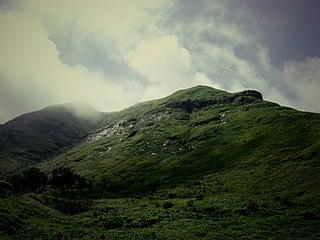
Nashik district, also known as Nasik district, is a district in Maharashtra, India. The city of Nashik is the administrative headquarters of the district. Nashik is well known for the production of wine. Nashik is also known as Mini Maharashtra, because the climate and soil conditions of Surgana, Peth, Igatpuri resembles with Konkan. Niphad, Sinnar, Dindori, Baglan blocks are like Western Maharashtra and Yeola, Nandgaon, Chandwad blocks are like Vidarbha Region. Nashik is the biggest city in the district while malegaon is the second biggest city. Manmad, Igatpuri, sinnar are some of the big cities situated in the Nashik District. manmad is one of the biggest railway junction in india while the city of malegaon is famous for its powerlooms

Sawantwadi is a taluka in the Sindhudurg district in the Indian state of Maharashtra. The taluka headquarters is Sawantwadi which has a municipal council, which is a local civic body. Sawantwadi was formerly the capital of the Kingdom of Sawantwadi, ruled by the Sawant Bhonsle royal clan of the Marathas.

Mahad is a city in Raigad district situated in the North Konkan region of Maharashtra state, India. It is located 108.5 km (67.4 mi) from District's Headquarter Alibag, and 167 km (104 mi) from Mumbai, the state capital of Maharashtra and economic capital of India, towards western coast. Historically, the city contains the Raigad fort, the capital of Maratha Empire in Shivaji Maharaj's era and revolutionary Mahad Satyagraha launched by Dr. Babasaheb Ambedkar at Chavdar Tale in the wake of Modern India.
Tamhini Ghat is a mountain passage located between Mulshi and Tamhini in Maharashtra, India.

Chandoli National Park is a national park spread over Satara, Kolhapur and Sangli Districts, Maharashtra state, India, established in May 2004. Earlier it was a Wildlife Sanctuary declared in 1985. Chandoli Park is notable as the southern portion of the Sahyadri Tiger Reserve, with Koyna Wildlife Sanctuary forming the northern part of the reserve

Chandgad is a Small city and tehsil headquarters of chandgad taluka, of Kolhapur district that is in the Indian state of Maharashtra.

Savitri River is one of the 5 rivers which originate from Mahabaleshwar in Maharashtra state in India.It originates at Savitri point near Mahabaleshwar and flows through the bankot village and directly goes to Arabian sea Raigad district and eventually meets Arabian Sea at Harehareshwar. It passes through rocky and hilly terrain of western ghats till Poladpur and further through the towns of Mahad, Mangaon and Shrivardhan Tehsil (taluka). There are a number of Shiva temples along the banks of river Savitri. Many other small rivers get merged into it at Kapade, Poladpur and Birwadi. Its major tributary is the Kal River which enters from the right (north) near Dasgaon.
The Jagbudi river is the small river merging into Vashishti river. It meets Vasishthi near Bahirwali. It comes from Khed to Bahiravali. It Originates from Khopi in Ratnagiri district, Maharashtra, India.
Shoolpaneshwar Wildlife Sanctuary is a protected area in India's Gujarat state, located in the western Satpura Range south of the Narmada River and is 607.7 km2 (234.6 sq mi) large. It shares a common boundary with Madhya Pradesh and Maharashtra. It encompasses mixed dry deciduous forest, riverine forest, few pockets of moist teak forest, agricultural fields and two water reservoirs. It was established in 1982.

Bhor Saidan Crocodile Breeding Centre, managed by the Haryana Forests Department to captive breed and conserve the freshwater mugger crocodile native to India, is located at Bhor Saidan village on Kurukshetra-Pehowa Road in Kurukshetra district of Haryana in India. It is 13 km from the old Kurukshetra Bus Stand and 22 km from the new Kurukshetra Bus Stand in sector 10.
Tumbbad is a village located on the banks of Jagbudi River in Ratnagiri district's Ratnagiri taluka in Maharashtra's Konkan division. The village is about 100 kilometres away from the Koyna Wildlife Sanctuary. The village is famous for its Mugger Crocodile


















